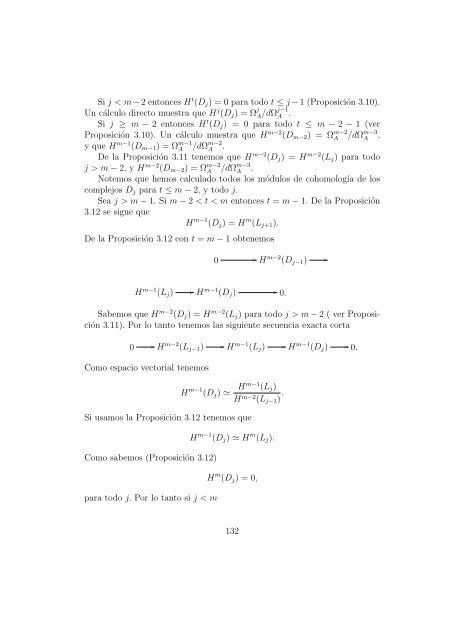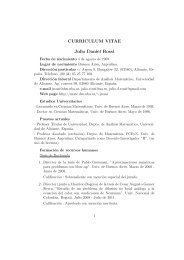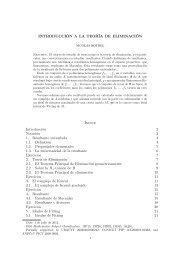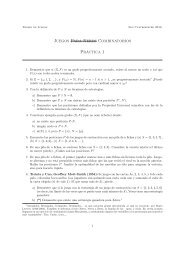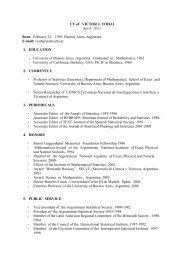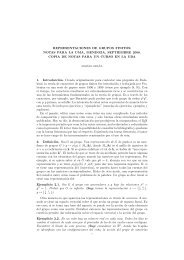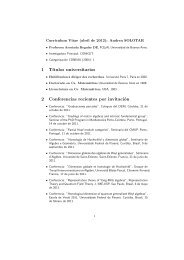- Page 1 and 2:
Resumen Sea A = R/I un anillo regul
- Page 3 and 4:
Índice general Introducción III 1
- Page 5 and 6:
Introducción En la presente tesis
- Page 7 and 8:
para valores j mayores que la dimen
- Page 9 and 10:
E 1 2,0 = T or2(Mk, R I ) E1 1,0 =
- Page 11 and 12:
En relación a la homología cícli
- Page 13 and 14:
atra´s nos permiten establecer el
- Page 15 and 16:
Otra forma de abordar el estudio de
- Page 17 and 18:
1.1. Homología de Hochschild En es
- Page 19 and 20:
Definición 1.5. Sean A una k-álge
- Page 21 and 22:
Observación. Notemos que todas las
- Page 23 and 24:
Observación. En esta tesis trabaja
- Page 25 and 26:
〈f1, . . . , ft〉 . El jacobiano
- Page 27 and 28:
En efecto, como df = Σi=1,...,mfid
- Page 29 and 30:
σ |σ|σ(a0a ′ 0, a1, . . . , a
- Page 31 and 32:
1.2. Homología Cíclica. Presentam
- Page 33 and 34:
Prueba. Es suficiente tomar la secu
- Page 35 and 36:
Definamos los módulos HHn(A) ˜ :=
- Page 37 and 38:
Observación. De las definiciones a
- Page 39 and 40:
Prueba. La demostración se basa en
- Page 41 and 42:
La homología cíclica del A.D.G (A
- Page 43 and 44:
entonces T ot(D)n = p+q=n i≥0 M
- Page 45 and 46:
Proposición 1.79. Sea (Mp,q, b) y
- Page 47 and 48:
donde N = 〈1 ⊗ ab − (−1) |a
- Page 49 and 50:
concluimos la prueba del lema. Una
- Page 51 and 52:
Sean x, y elementos en ∧V. Sin pe
- Page 53 and 54:
con δ|∧V ⊗∧V = m tal que el
- Page 55 and 56:
Prueba. Para el caso θ ◦ b = 0 :
- Page 57 and 58:
indicando con ello que θ ′ 1 es
- Page 59 and 60:
Prueba. [CGG, Corolario 2.7]. Note
- Page 61 and 62:
y ϕ j m : ξ j m −→ Im−j Ω
- Page 63 and 64:
donde 1 ≤ s ≤ p y |xj∗| = |xj
- Page 65 and 66:
para convertir a los polinomios f1,
- Page 67 and 68:
términos de cohomología no nulos.
- Page 69 and 70:
tal que η j · M = 0. En el caso q
- Page 71 and 72:
Ejemplo 2.12. Sea I = 〈x 2 , y 3
- Page 73 and 74:
Supongamos que el Lema se cumple pa
- Page 75 and 76:
De aquí se tiene que ht(JF ) = m
- Page 77 and 78:
Prueba. Nuevamente como W tiene a l
- Page 79 and 80:
(ver Proposición A.38 del Apéndic
- Page 81 and 82:
es un polinomio no nulo (ver Lema A
- Page 83 and 84:
Lj : 0 IjΩ0 R Ij+1Ω0 R dDR I
- Page 85 and 86:
donde δ(y (a1) 1 . . . y (ar) r y
- Page 87 and 88:
donde df denota la imagen de df ∧
- Page 89 and 90:
Observación. Notemos que Lm+p = L
- Page 91 and 92:
en H m−1 (K(f1, . . . , fm)). Por
- Page 93 and 94:
para todo i (ver [Wei, Aplicación
- Page 95 and 96: . . . δ |a|=j−m+1 x a1 1 · ·
- Page 97 and 98: Notemos que puede ocurrir que ai
- Page 99 and 100: 2.2.3. Cálculo de la Homología de
- Page 101 and 102: como T dx1 = df, T dx2 = dg y T dxi
- Page 103 and 104: Prueba. Sea P un ideal primo en el
- Page 105 and 106: Cp+1 : . Ω m−2 2,p+2 df Ω
- Page 107 and 108: Por lo tanto Gr(H m−1 (C1)) = H m
- Page 109 and 110: Con esta notación el bicomplejo L
- Page 111 and 112: Teorema 2.62. Existe una secuencia
- Page 113 and 114: intercambiar el rol de f por el de
- Page 115 and 116: Como dg ∧ η 1 1, dg ∧ η 2 1
- Page 117 and 118: son cero, para todo p ≥ 1. En efe
- Page 119 and 120: 2.3. Homología de Hochschild para
- Page 121 and 122: se trata de M(x1, . . . , xr) el de
- Page 123 and 124: Lema 2.72. Los complejo T ot(B) y L
- Page 125 and 126: Bp+1,−p δ1 dfr Bp,−p δ1 .
- Page 127 and 128: y a1 1 · · · yar r ω → y a1 1
- Page 129 and 130: Teorema 2.76. Sea (R, η) un anillo
- Page 131 and 132: En el caso que el ideal I = 〈f, g
- Page 133 and 134: para todo i = m − r + 1. Del crit
- Page 135 and 136: En general los módulos de cohomolo
- Page 137 and 138: Capítulo 3 Homología Cíclica. Lo
- Page 139 and 140: el complejo Lj tiene cohomología c
- Page 141 and 142: para todo t ≤ m − r − 2. Si t
- Page 143 and 144: 3.2. El Caso Quasihomogéneo En est
- Page 145: tomamos la secuencia exacta larga
- Page 149 and 150: Observación. Del Capítulo anterio
- Page 151 and 152: Prueba. El Lema 3.15 nos permite as
- Page 153 and 154: Definamos el número de Milnor de l
- Page 155 and 156: entonces en el anillo R/Jf,g tendr
- Page 157 and 158: . . . . B d Ω2,1 B . d Ω1,1
- Page 159 and 160: Como lím 1 H( ˆ Dj) = 0 entonces
- Page 161 and 162: . . . Ωm−1 · x · xp+2 ⊕ Ω
- Page 163 and 164: El complejo L ′ m+p se escribe co
- Page 165 and 166: Lema 3.28. El morfismo β restricto
- Page 167 and 168: Si z = ωxiyj y ∈ (E ′ m+p(0))t
- Page 169 and 170: Gr(H m (Γ(f, g))) = ⊕p≥0H m (E
- Page 171 and 172: F y una filtración del mismo. Del
- Page 173 and 174: Prueba. Por definición (E ′ m+p(
- Page 175 and 176: se denotará como β β . . . E∗
- Page 177 and 178: Prueba. La demostración será por
- Page 179 and 180: . . . 0 Lm+p−i−1(f) 0 Lm+p−
- Page 181 and 182: Como β(x) = x, entonces el morfism
- Page 183 and 184: que finalizan en I. Si el ideal I n
- Page 185 and 186: Definición A.9. Sea (R, η) un ani
- Page 187 and 188: Observación. Notemos que esta defi
- Page 189 and 190: Prueba. [Mats, Teorema 36]. . Defin
- Page 191 and 192: A.2. Complejo Koszul Nuestro princi
- Page 193 and 194: Prueba. [Eis, Teorema 17.1] . Corol
- Page 195 and 196: De la hipótesis inductiva se sigue
- Page 197 and 198:
Observación. Notemos también que
- Page 199 and 200:
Prueba. Del Corolario anterior tene
- Page 201 and 202:
Por lo tanto fk,j = s gk,iλi,j, es
- Page 203 and 204:
Como M/N η · M/N = M N ⊗ R/η,
- Page 205 and 206:
esta bien definida. Más aún si x
- Page 207 and 208:
Como h(dx), h(dy) ∈ J y J 2 = 0 (
- Page 209 and 210:
Prueba. Del Lema A.61 tenemos que Q
- Page 211 and 212:
[CGG] Cortiñas, G., Guccionne, J.A


